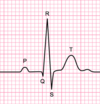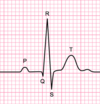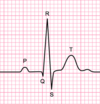S6) The ECG Flashcards
What is the ECG?
- The ECG is a device used to measure the electrical activity of the heart by using electrodes placed on the skin
- This is an extracellular recording of the combined spread of electrical activity across the whole heart
Which structures compose the specialised conducting system of the heart?
- SAN (sinus rhythm)
- AV node
- Bundle of His
- Right and Left bundle branches
- Fibres of the Purkinje system

In 9 steps, outline how action potentials spread over the heart in a precise pattern

Which different complexes can form for depolarisation waves?

Repolarisation of the ventricles happens in the reverse order.
Thus, which different complexes can form from repolarisation waves?

What determines the nature of the signal?
The nature of the signal depends upon the direction of spread of the electric field relative to the position of the recording electrode
How can the nature of the signal be predicted in terms of repolarisation and depolarisation?
- Depolarisation towards a positive recording electrode → upward deflection
- Depolarisation away from a positive recording electrode → downward deflection
- Repolarisation towards a positive recording electrode → downward deflection
- Repolarisation away from a positive recording electrode → upward deflection
Which factors affect the amplitude of the deflection?
- Size and speed of muscle changing potential
- Direction of wave of activity towards the electrode (directly, obliquely, perpendicular)
Describe the electrical activity in this 5 individual diagrams and the depolarisation complexes they form


What is the mechanism behind the P wave?

P wave: atrial depolarisation spreads along both atrial fibres & internodal pathways towards the AV node

What is the mechanism behind the Q segment?

Q segment: the initial downward deflection after the P wave as the muscle in the interventricular septum depolarises from left to right

What is the mechanism behind the QRS segment?

QRS segment: ventricular depolarisation

What is the mechanism behind the R segment?

R segment: initial upward deflection after p wave (large as there is greater muscle mass i.e. more electrical activity)

What is the mechanism behind the S segment?

S segment: downward deflection after the R as depolarisation finally spreads upwards to the base of the ventricles

What is the mechanism behind the T segment?

T segment: ventricular repolarisation (epicardial surface → endocardium) produces medium upward deflection

What is the R-R interval in the ECG and what is its significance?
- Where to measure: from peak to peak of R-waves
- What does this indicate: shorter interval = faster heart rate

What is the QRS complex in the ECG and what is its significance?
- Where to measure: start of the Q-wave to the end of the S-wave
- What does this indicate: wider QRS complexes are associated with abnormal ventricular depolarisations

What is the P-R interval in the ECG and what is its significance?
- Where to measure: start of the P-wave to start of the Q-wave
- What does this indicate: longer P-R intervals indicate slow conduction from the atria to the ventricle (first degree heart block)

What is the ST segment in the ECG and what is its significance?
- Where to measure: end of S-wave to start of T-wave
- What does this indicate: the ST segment should be isoelectric (myocardial infarction/ischaemia if raised/depressed)

What is the Q-T interval in the ECG and what is its significance?
- Where to measure: start of Q-wave to end of T-wave
- What does this indicate: a prolonged Q-T interval suggests prolonged repolarisation of the ventricles, lead to arrhythmias

Explain the relationship of the Q-T interval with the heart rate, and how this can be adjusted for
- The faster the heart rate, the shorter the R-R and Q-T interval
- This can be adjusted to improve the detection of patients with increased risk of ventricular arrhythmia (QTc)
How many electrodes are used to record the ECG and where are they placed?
- Limbs: 4 electrodes (A)
- Chest: 6 electrodes (B)

What are the colours of the different limb electrodes?
Mnemonic: Ride Your Green Bike

What are the colours of the different chest electrodes?
Mnemonic: Ride Your Great Big Brown Pony

Identify the specific locations of the different chest leads
- V1: 4th intercostal space (right sternal border)
- V2: 4th intercostal space (left sternal border)
- V3: Between V2 and V4
- V4: 5th intercostal space (mid-clavicular line)
- V5: Between V4 and V6
- V6: 6th intercostal space (mid-axillary line)

How many different views/leads are given of the heart?
12 views
What are the 6 different views in the vertical plane (limb leads)?

Which views are given by limb leads: II, III and aVF?
They look at the inferior surface of the heart

Which views are given by limb leads: I and aVL?
They look at the left side of the heart

What are the 6 different views in the horizontal plane (chest leads)?

Which views are given by chest leads: V1 and V2 (aka septal leads)?
They look at the right ventricle & septum

Which views are given by chest leads: V3 and V4 (aka anterior leads)?
They look at the anterior wall of the ventricles

Which views are given by chest leads: V5 and V6 (aka lateral leads)?
They look at the left ventricle

Which ECG leads can detect problems in the lateral surface of the heart?
I, aVL, V5, V6

Which ECG leads can detect problems in the inferior surface of the heart?
II, III, aVF

Which ECG leads can detect problems in the septum of the heart?
V1 and V2

Which ECG leads can detect problems in the anterior surface of the heart?
V3 and V4

In an ECG trace, how much is the following:
- 1 large square (width)
- 1 large square (length)
- 1 small square (width)
- 1 large square = 0.2 seconds (width)
- 1 large square = 0.5 mV (length)
- 1 small square = 0.04 seconds (length)

How does one determine normal sinus rhythm?

Distinguish between sinus bradycardia and sinus tachycardia
- Sinus rhythm with rate < 60/minute = sinus bradycardia
- Sinus rhythm with rate > 100/minute = sinus tachycardia

How does one calculate heart rate from an ECG with a regular rhythm?
- Count the number of large boxes between complexes (R – R interval)
- How many complexes could be fitted into 300 large boxes ( i.e. 1 minute)?
- E.g. 300/4 = 75 beats per minute*

How does one calculate heart rate from an ECG with an irregular rhythm?
Calculate heart rate by counting the number of QRS complexes in 6 seconds, then multiply by 10

E.g. Heart rate = 70 beats per minute
With reference to the electrical activity of the heart, describe what is happening at each of the numbered points

1 - SAN depolarisation
2 - Atrial depolarisation
3 - AVN delay
4 - Ventricular depolarisation



